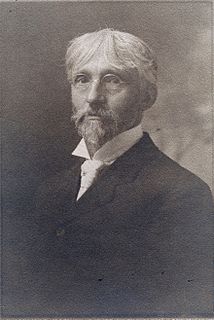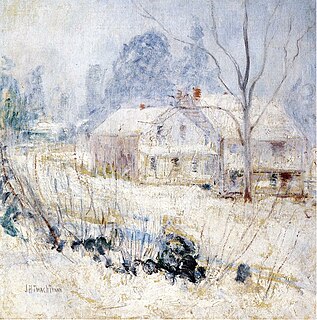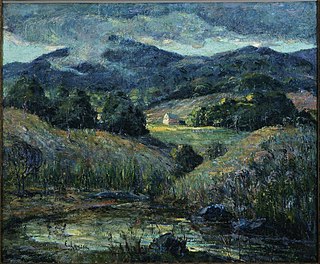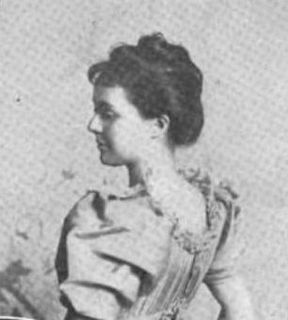
American Impressionism was a style of painting related to European Impressionism and practiced by American artists in the United States during the late 19th and early 20th centuries. American Impressionism is a style of painting characterized by loose brushwork and vivid colors. The style often depicted landscapes mixed with scenes of upper-class domestic life.

John Henry Twachtman was an American painter best known for his impressionist landscapes, though his painting style varied widely through his career. Art historians consider Twachtman's style of American Impressionism to be among the more personal and experimental of his generation. He was a member of "The Ten", a loosely allied group of American artists dissatisfied with professional art organizations, who banded together in 1898 to exhibit their works as a stylistically unified group.

Julian Alden Weir was an American impressionist painter and member of the Cos Cob Art Colony near Greenwich, Connecticut. Weir was also one of the founding members of "The Ten", a loosely allied group of American artists dissatisfied with professional art organizations, who banded together in 1898 to exhibit their works as a stylistically unified group.

Frederick Childe Hassam was an American Impressionist painter, noted for his urban and coastal scenes. Along with Mary Cassatt and John Henry Twachtman, Hassam was instrumental in promulgating Impressionism to American collectors, dealers, and museums. He produced over 3,000 paintings, oils, watercolors, etchings, and lithographs over the course of his career, and was an influential American artist of the early 20th century.

The Ten American Painters was an artists' group formed in 1898 to exhibit their work as a unified group. John Henry Twachtman, J. Alden Weir, and Childe Hassam were the driving forces behind the organization. Dissatisfied with the conservatism of the American art establishment, the three artists recruited seven others from Boston, New York City, and elsewhere on the East Coast, with the intention of creating an exhibition society that valued their view of originality, imagination, and exhibition quality. The Ten achieved popular and critical success, and lasted two decades before dissolving.

Theodore Robinson was an American painter best known for his Impressionist landscapes. He was one of the first American artists to take up Impressionism in the late 1880s, visiting Giverny and developing a close friendship with Claude Monet. Several of his works are considered masterpieces of American Impressionism.

Leonard Ochtman was an Dutch-American Impressionist painter who specialized in landscapes. He was a founding member of the Cos Cob Art Colony and the Greenwich Society of Artists.

Cos Cob is a neighborhood and census-designated place in the town of Greenwich, Connecticut. It is located at 41.033 north, 73.6 west, on the Connecticut shoreline in southern Fairfield County. It had a population of 6,770 at the 2010 census.

The Bush–Holley House is a National Historic Landmark and historic house museum at 39 Strickland Road in the Cos Cob section of Greenwich, Connecticut. It was constructed circa 1730 and in the late nineteenth century was a boarding house and the center of the Cos Cob Art Colony, Connecticut's first art colony. From 1890 to 1920, the house was a gathering place for artists, writers and editors, and scores of art students came to study with leading American Impressionists John Henry Twachtman, J. Alden Weir, Theodore Robinson, and Childe Hassam. It is currently operated as a historic site by the Historical Society of the Town of Greenwich, and is open for tours.

Ernest Lawson was a Canadian-American painter and a member of The Eight, a group of artists who formed a loose association in 1908 to protest the narrowness of taste and restrictive exhibition policies of the conservative, powerful National Academy of Design. Though Lawson was primarily a landscape painter, he also painted a small number of realistic urban scenes. His painting style is heavily influenced by the art of John Henry Twachtman, J. Alden Weir, and Alfred Sisley. Though considered an American Impressionist, Lawson falls stylistically between Impressionism and realism.

The Bruce Museum is a museum in downtown Greenwich, Connecticut with both art and natural history exhibition space. The Bruce's main building sits on a hill in a downtown park, and its tower can be easily seen by drivers passing by on Interstate 95. Permanent exhibits include minerals, area Native American history and culture, changes in the area landscape and environment by human activity, and dioramas of Connecticut woodland wildlife and birds. The museum hosts changing exhibitions of art, photography, natural history, science, history and culture.

The history of Greenwich, Connecticut.
Mina Fonda Ochtman (1862–1924) was an American Impressionist painter noted for her watercolors of landscapes and coastal scenes. She was wife of the artist Leonard Ochtman, and an active member of the Cos Cob Art Colony in Greenwich, Connecticut the early 20th century.

The Florence Griswold Museum is an art museum at 96 Lyme Street in Old Lyme, Connecticut centered on the home of Florence Griswold (1850–1937), which was the center of the Old Lyme Art Colony, the main center of American Impressionism. The museum is noted for its collection of American Impressionist paintings. The house was designated a National Historic Landmark in 1993.
Clark Greenwood Voorhees was an American Impressionist and Tonalist landscape painter and one of the founders of the Old Lyme Art Colony.

Matilda Browne was an American Impressionist artist noted for her flower paintings and her farm and cattle scenes. Born in Newark, New Jersey, she was a child prodigy who received early art training from her artist-neighbor, Thomas Moran.

Elmer Livingston MacRae (1875–1953) was an American visual artist known for his paintings, pastels, and sketches, and for his role as a leading member of the Cos Cob Art Colony, in Greenwich, Connecticut. MacRae was one of the organizers of the influential 1913 Armory Show in New York; he was also instrumental in founding the American Pastel Society, as well as the Greenwich Society of Artists.
Known originally as The Greenwich Society of Artists, the Greenwich Art Society is an organization dedicated to promoting arts education in the town of Greenwich, Connecticut. It was founded in 1912 by artists affiliated with the "Cos Cob School," and many associated with the development of the American Impressionist movement, who sought “the promotion and maintenance of the fine arts and the exhibition of works of art in Greenwich.”

Allen Butler Talcott was an American landscape painter. After studying art in Paris for three years at Académie Julian, he returned to the United States, becoming one of the first members of the Old Lyme Art Colony in Connecticut. His paintings, usually landscapes depicting the local scenery and often executed en plein air, were generally Barbizon and Tonalist, sometimes incorporating elements of Impressionism. He was especially known and respected for his paintings of trees. After eight summers at Old Lyme, he died there at the age of 41.
Katherine Langhorne Adams (1885–1977) was an American painter and printmaker. Other sources give her birthdate as c. 1882 and 1890.
















